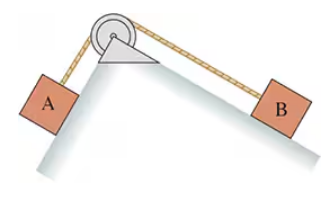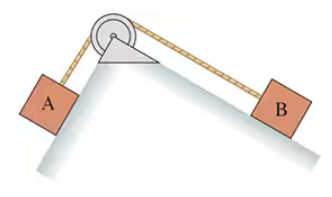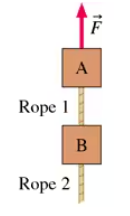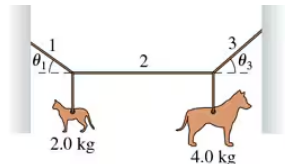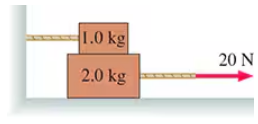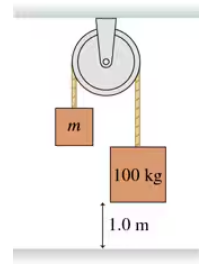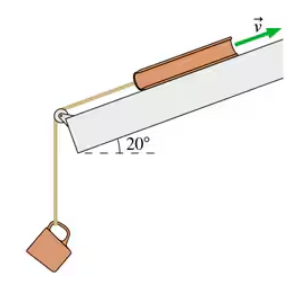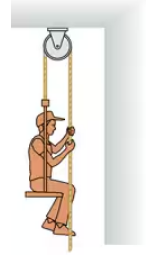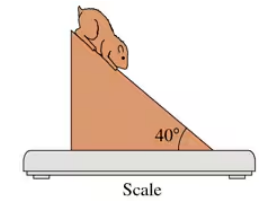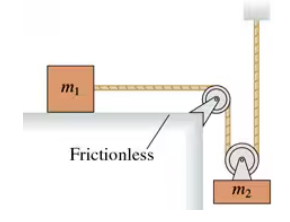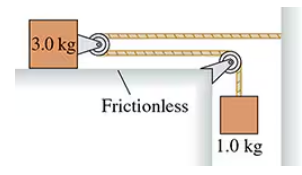 Back
BackProblem 1c
A tennis racket swung over the server's head hits a tennis ball horizontally. Draw a free-body diagram for each object in the system. Use dashed lines to connect members of an action/reaction pair.
Problem 2b
A weightlifter stands up at constant speed from a squatting position while holding a heavy barbell across his shoulders. Identify the "system" on your interaction diagram.
Problem 3a
A heavy steel cable attached to a motor is lifting a girder. The girder is speeding up. Draw an interaction diagram.
Problem 4a
Block A in FIGURE EX7.4 is sliding down the incline. The rope is massless, and the massless pulley turns on frictionless bearings, but the surface is not frictionless. The rope and the pulley are among the interacting objects, but you'll have to decide if they're part of the system. Draw an interaction diagram.
Problem 4c
Block A in FIGURE EX7.4 is sliding down the incline. The rope is massless, and the massless pulley turns on frictionless bearings, but the surface is not frictionless. The rope and the pulley are among the interacting objects, but you'll have to decide if they're part of the system. Draw a free-body diagram for each object in the system. Use dashed lines to connect members of an action/reaction pair.
Problem 7b
How much force does the astronaut exert on his chair while accelerating straight up at 10 m/s2?
Problem 8a
A 1000 kg car is pushing an out-of-gear 2000 kg truck that has a dead battery. When the driver steps on the accelerator, the drive wheels of the car push horizontally against the ground with a force of 4500 N. Rolling friction can be neglected. What is the magnitude of the force of the car on the truck?
Problem 9b
Blocks with masses of 1 kg, 2 kg, and 3 kg are lined up in a row on a frictionless table. All three are pushed forward by a 12 N force applied to the 1 kg block. How much force does the 2 kg block exert on the 1 kg block?
Problem 12b
The foot of a 55 kg sprinter is on the ground for 0.25 s while her body accelerates from rest to 2.0 m/s. What is the magnitude of the friction force?
Problem 15
The sled dog in FIGURE EX7.15 drags sleds A and B across the snow. The coefficient of friction between the sleds and the snow is 0.10. If the tension in rope 1 is 150 N, what is the tension in rope 2?
Problem 17b
FIGURE EX7.17 shows two 1.0 kg blocks connected by a rope. A second rope hangs beneath the lower block. Both ropes have a mass of 250 g. The entire assembly is accelerated upward at 3.0 m/s2 by force F. What is the tension at the top end of rope 1?
Problem 18b
A 2.0-m-long, 500 g rope pulls a 10 kg block of ice across a horizontal, frictionless surface. The block accelerates at 2.0 m/s2. How much force pulls forward on he rope? Assume that the rope is perfectly horizontal.
Problem 19
A 500 kg air conditioner sits on the flat roof of a building. The coefficient of static friction between the roof and the air conditioner is 0.90. A massless rope attached to the air conditioner passes over a massless, frictionless pulley at the edge of the roof. In an effort to drag the air conditioner to the edge of the roof, four 100 kg students hang from the free end of the rope, but the air conditioner refuses to budge. What is the magnitude of the rope tension at the point where it is attached to the air conditioner?
Problem 21
A mobile at the art museum has a 2.0 kg steel cat and a 4.0 kg steel dog suspended from a lightweight cable, as shown in FIGURE EX7.21. It is found that = 20° when the center rope is adjusted to be perfectly horizontal. What are the tension and the angle of rope 3?
Problem 23a
The 1.0 kg block in FIGURE EX7.23 is tied to the wall with a rope. It sits on top of the 2.0 kg block. The lower block is pulled to the right with a tension force of 20 N. The coefficient of kinetic friction at both the lower and upper surfaces of the 2.0 kg block is μk = 0.40. What is the tension in the rope attached to the wall?
Problem 24
The 100 kg block in FIGURE EX7.24 takes 6.0 s to reach the floor after being released from rest. What is the mass of the block on the left? The pulley is massless and frictionless.
Problem 25
Two blocks are attached to opposite ends of a massless rope that goes over a massless, frictionless, stationary pulley. One of the blocks, with a mass of 6.0 kg, accelerates downward at (3/4)g. What is the mass of the other block?
Problem 28
A rope of length L and mass m is suspended from the ceiling. Find an expression for the tension in the rope at position y, measured upward from the free end of the rope.
Problem 29b
An 85 kg cheerleader stands on a scale that reads in kg. What does the scale read if the 85 kg cheerleader lifts the 50 kg cheerleader upward with an acceleration of 2.0 m/s²?
Problem 30a
Your forehead can withstand a force of about 6.0 kN before fracturing, while your cheekbone can withstand only about 1.3 kN. Suppose a 140 g baseball traveling at 30 m/s strikes your head and stops in 1.5 ms. What is the magnitude of the force that stops the baseball?
Problem 32b
A 75 kg archer on ice skates is standing at rest on very smooth ice. He shoots a 450 g arrow horizontally. When released, the arrow reaches a speed of 110 m/s in 0.25 s. Assume that the force of the bow string on the arrow is constant. What is the archer's recoil speed?
Problem 36b
A 2.0 kg block on a horizontal, frictionless surface is connected by a massless spring and a massless, frictionless pulley to a hanging mass. For what value of the hanging mass does the block accelerate at 1.5 m/s²?
Problem 40b
The 1.0 kg physics book in FIGURE P7.40 is connected by a string to a 500 g coffee cup. The book is given a push up the slope and released with a speed of 3.0 m/s. The coefficients of friction are μs = 0.50 and μk = 0.20. At the highest point, does the book stick to the slope, or does it slide back down?
Problem 45
A house painter uses the chair-and-pulley arrangement of FIGURE P7.45 to lift himself up the side of a house. The painter's mass is 70 kg and the chair's mass is 10 kg. With what force must he pull down on the rope in order to accelerate upward at 0.20 m/s².
Problem 47
FIGURE P7.47 shows a 200 g hamster sitting on an 800 g wedge-shaped block. The block, in turn, rests on a spring scale. An extra-fine lubricating oil having μs = μk = 0 is sprayed on the top surface of the block, causing the hamster to slide down. Friction between the block and the scale is large enough that the block does not slip on the scale. What does the scale read, in grams, as the hamster slides down?
Problem 54
In FIGURE CP7.54, find an expression for the acceleration of m1. The pulleys are massless and frictionless. Hint: Think carefully about the acceleration constraint.
Problem 55
What is the acceleration of the 3.0 kg block in FIGURE CP7.55 across the frictionless table? Hint: Think carefully about the acceleration constraint.

